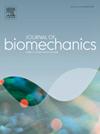Biomechanical mechanisms for modulating stride frequency in walking
IF 2.4
3区 医学
Q3 BIOPHYSICS
引用次数: 0
Abstract
Humans typically choose to walk at a self-selected stride frequency that minimizes their metabolic cost. However, when environmental constraints are present (e.g., icy sidewalk), they will change their stride frequency to accommodate. This study provides a comprehensive understanding of the muscle–tendon dynamics when humans walk with different stride frequencies, offering valuable insights into the biomechanics of walking. The study aimed to quantify the effect of stride frequency on the muscle–tendon forces, powers, and induced accelerations on the center of mass. Data was collected with eight subjects walking at 1.3 m/s at their self-selected stride frequency and + 20 and −20 % of their self-selected stride frequency. We used musculoskeletal modeling to compute the muscle–tendon forces and powers, and the vertical and anterior-posterior induced accelerations for nine muscle groups. When comparing stride frequency conditions using statistical parametric mapping, we found that gluteus medius, gastrocnemius, and tibialis anterior had greater forces, powers, or induced accelerations in the −20 % condition. The hamstrings, rectus femoris, and iliopsoas muscle groups had greater forces, powers, or induced accelerations in the + 20 % condition compared to self-selected frequency. The gastrocnemius played a crucial role in modulating forward acceleration across different stride frequencies, driven by changes in segment kinematics rather than changes in muscle forces. Increases in muscle force production as participants deviated from self-selected stride frequency may indicate that the preferred stride frequency of an individual minimizes the overall demand on lower limb muscles during walking. These results advance our understanding of why humans self-select certain movement patterns during gait.
求助全文
约1分钟内获得全文
求助全文
来源期刊

Journal of biomechanics
生物-工程:生物医学
CiteScore
5.10
自引率
4.20%
发文量
345
审稿时长
1 months
期刊介绍:
The Journal of Biomechanics publishes reports of original and substantial findings using the principles of mechanics to explore biological problems. Analytical, as well as experimental papers may be submitted, and the journal accepts original articles, surveys and perspective articles (usually by Editorial invitation only), book reviews and letters to the Editor. The criteria for acceptance of manuscripts include excellence, novelty, significance, clarity, conciseness and interest to the readership.
Papers published in the journal may cover a wide range of topics in biomechanics, including, but not limited to:
-Fundamental Topics - Biomechanics of the musculoskeletal, cardiovascular, and respiratory systems, mechanics of hard and soft tissues, biofluid mechanics, mechanics of prostheses and implant-tissue interfaces, mechanics of cells.
-Cardiovascular and Respiratory Biomechanics - Mechanics of blood-flow, air-flow, mechanics of the soft tissues, flow-tissue or flow-prosthesis interactions.
-Cell Biomechanics - Biomechanic analyses of cells, membranes and sub-cellular structures; the relationship of the mechanical environment to cell and tissue response.
-Dental Biomechanics - Design and analysis of dental tissues and prostheses, mechanics of chewing.
-Functional Tissue Engineering - The role of biomechanical factors in engineered tissue replacements and regenerative medicine.
-Injury Biomechanics - Mechanics of impact and trauma, dynamics of man-machine interaction.
-Molecular Biomechanics - Mechanical analyses of biomolecules.
-Orthopedic Biomechanics - Mechanics of fracture and fracture fixation, mechanics of implants and implant fixation, mechanics of bones and joints, wear of natural and artificial joints.
-Rehabilitation Biomechanics - Analyses of gait, mechanics of prosthetics and orthotics.
-Sports Biomechanics - Mechanical analyses of sports performance.
 求助内容:
求助内容: 应助结果提醒方式:
应助结果提醒方式:


